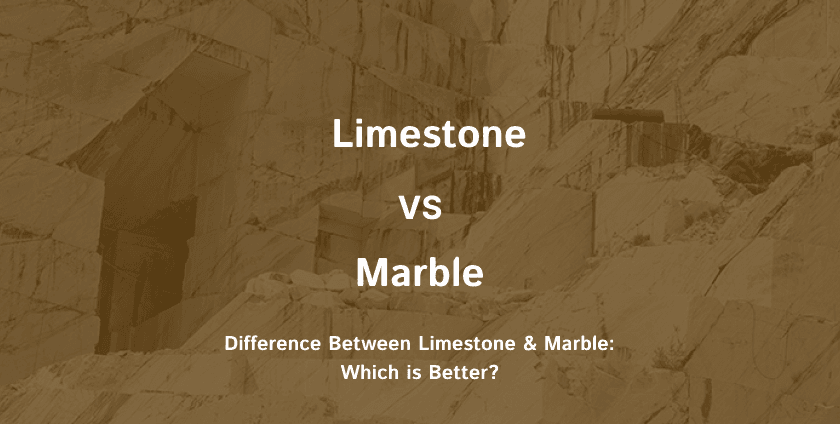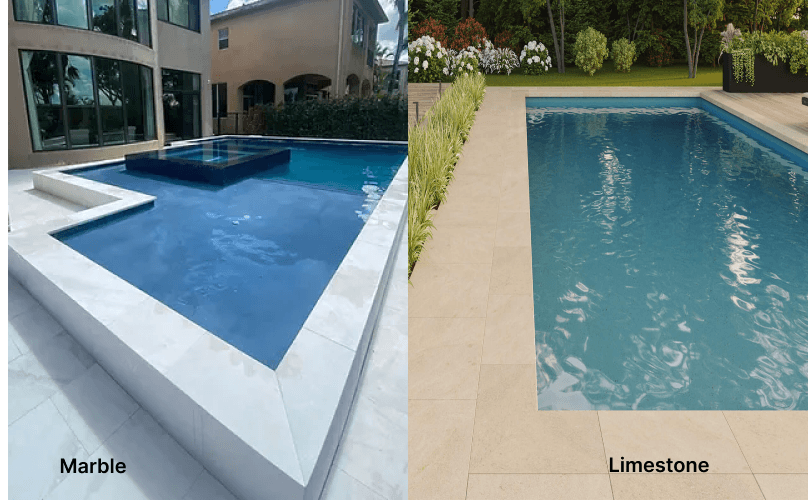Difference Between Limestone and Marble: Which is Better?
- By: Himanshi Bhadauria
- Category: Natural Stone

Limestone and marble are two different types of natural stone that are commonly used in construction, architecture, and interior design. Despite their apparent similarities, they differ in their compositions, uses, and qualities. In this blog, we will explore the key differences between limestone and marble to help you decide which stone is best for your upcoming construction project.
Limestone vs Marble: Formation and Composition
Limestone is a sedimentary rock formed by the accumulation of organic and mineral components such as shells, coral, and algae, over millions of years. It is mostly made up of calcium carbonate.

Marble, on the other hand, is a metamorphic rock formed when limestone undergoes extreme heat and pressure over time. This process, known as metamorphism, causes the calcium carbonate in limestone to recrystallize, producing a more compact and hard stone. As a result, marble has a finer texture and a unique veining pattern caused by impurities such as clay, silt, and iron oxide present in limestone during metamorphism.
Famous Limestone Varieties
Limestone is available in a wide variety of colors from white to tan, gray, or even brown, depending on the impurities and mineral concentration. Here’s a breakdown of the different types of limestone varieties that make them suitable for various uses in construction, landscaping, and decoration.
- Porous Limestone: Limestone with many small pores or cavities, making it less dense and more absorbent. It is commonly used for insulation or filtration purposes.
- Chocolate Limestone: A type of limestone with a brown or reddish-brown color, due to iron oxide content, often used for decorative purposes like flooring or countertops.
- Black Limestone: A dark-colored limestone, typically black or charcoal, often used in landscaping and building materials for its dramatic appearance.
- Crystalline Limestone: Limestone with visible mineral crystals, formed through heat and pressure, making it harder and more durable. It is often used for high-end construction.
- Moroccan Limestone: Limestone sourced from Morocco, known for its warm, golden, or beige tones. It’s used for both interior and exterior applications due to its attractive color and durability.
Marble vs Limestone: Key-Differences
| Characteristics | Limestone | Marble |
| Durability | Softer, more porous | Harder, denser, and more durable |
| Appearance | Subtle, often fossilized | Elegant with veining patterns |
| Uses | Construction, flooring, cement production | Countertops, sculptures, high-end flooring |
| Cost | Generally, more affordable | More expensive due to its luxurious appeal |
| Maintenance | Requires regular sealing and care | Requires sealing to prevent staining and etching |

Conclusion
Both limestone and marble are attractive natural stones with a wide range of applications that make them suitable for various purposes. Limestone is a cheaper and more natural option for outdoor and low-traffic areas, whereas marble adds elegance and refinement to locations where beauty and durability are important. Understanding these fundamental differences will help you make an informed decision about which stone is appropriate for your next project.
Purchase Limestone and Marble slabs from Stone Discover, the largest granite headstone monuments and natural stone suppliers. We are committed to providing premium quality products, including granite, marble, limestone and sandstone. Contact us today to elevate your next construction project with our service!
FAQs
Does limestone absorb water?
Yes, limestone is more prone to water absorption as it is a porous material.
Is Limestone expensive?
Limestone is quite affordable; however, the price varies based on criteria such as quality, origin, and processing. High-end variations, such as crystalline or unusual forms, are generally more expensive.
Why isn’t limestone a mineral?
Limestone isn’t considered a mineral because it is a sedimentary rock composed mainly of calcium carbonate.
Is limestone good for bathrooms?
Yes, limestone can be good for bathrooms due to its natural beauty, but limestone bathroom floors can be porous and absorb water, so it requires proper sealing to prevent damage.
Which mineral is found in both limestone and marble?
The mineral found in both limestone and marble is calcite (calcium carbonate).
Is Quartz or Limestone more porous?
Limestone is more porous than quartz, as limestone has a higher tendency to absorb water due to its natural porosity, whereas quartz is much denser and less porous.
- By: Himanshi Bhadauria
- Category: Natural Stone
